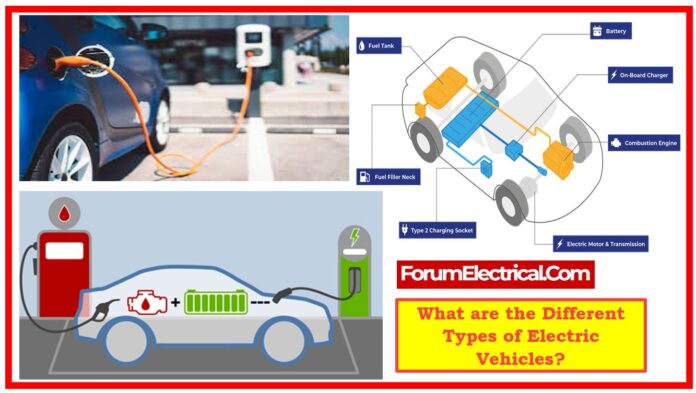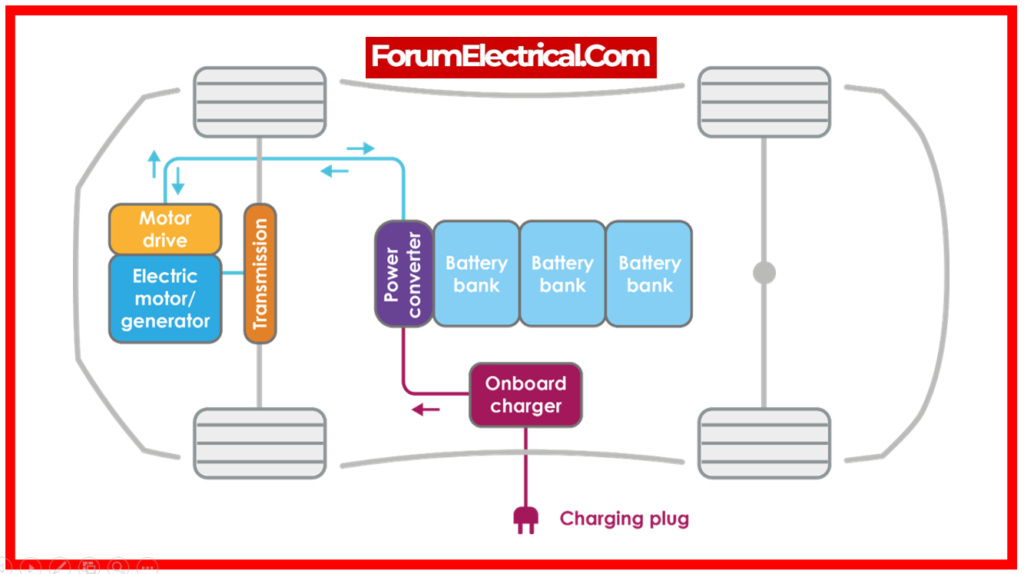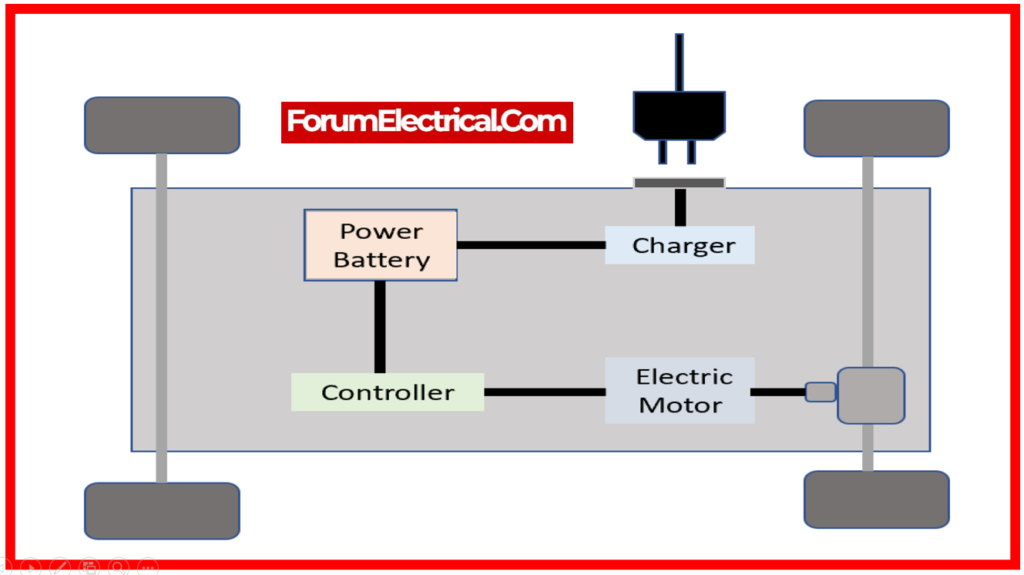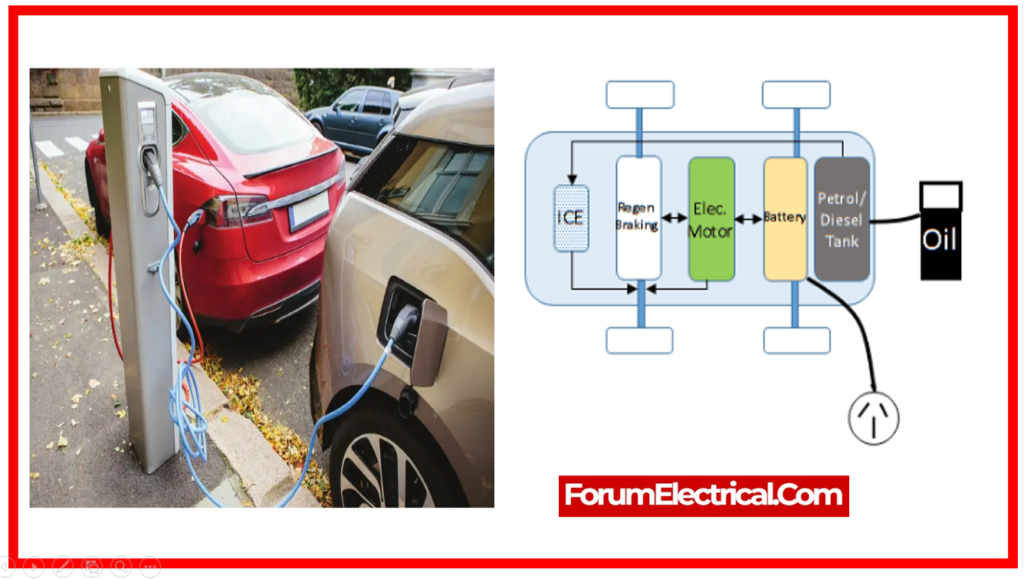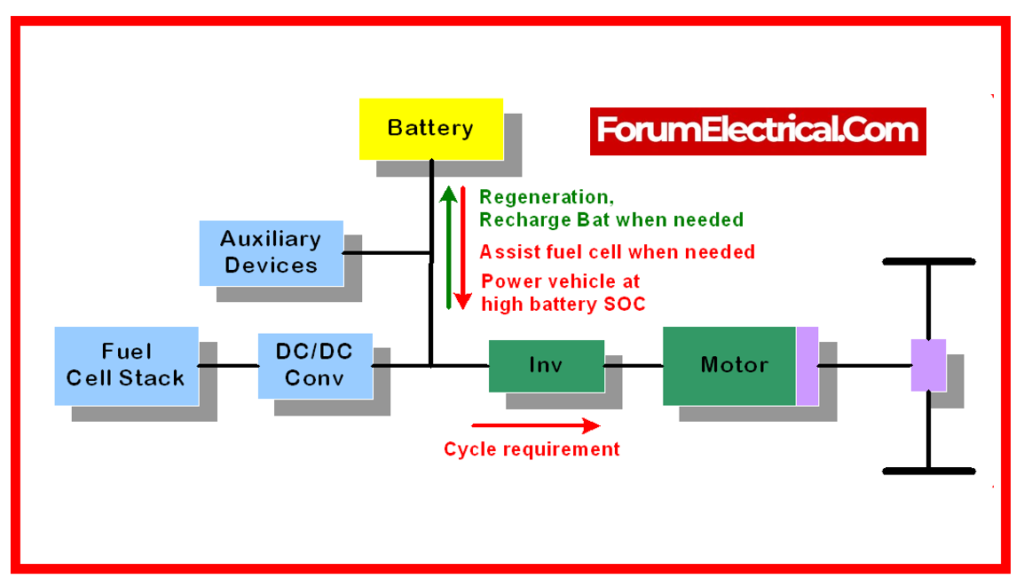What is called an Electric Vehicle (EV)?
EV – Electric Vehicle
An electric vehicle (EV) is one that is powered by an electric motor, takes electricity from a battery, and can be charged from an external source.
How does an Electric Vehicle Work?
In order to store electrical energy that is accessible to be used, an electric vehicle makes use of a battery. A battery pack is composed of several cells arranged into modules. The car is ready to go when the battery has enough energy stored in it. Modern battery technology has advanced significantly.
Types of Electric Vehicles
There are 4 different types of electric vehicles
- Battery Electric Vehicle (BEV): Powered entirely by electricity. These are more effective than hybrids and plug-in hybrids.
- Hybrid Electric Vehicle (HEV): The vehicle’s powertrain consists of an internal combustion (typically petrol) engine and a battery-powered motor. When the battery is empty, the petrol engine is utilized for both driving and charging. All-electric (or) plug-in hybrid automobiles are more fuel-efficient than these vehicles, which are less efficient.
- Plug-in Hybrid Electric Vehicle (PHEV): Plug-in Hybrid Electric Vehicle (PHEV) has both an internal combustion engine & a battery that is charged via an external socket (a plug). This means that the vehicle’s battery can be charged using electricity rather than its engine. PHEVs are more effective than HEVs, but not as efficient as BEVs.
- Fuel Cell Electric Vehicle (FCEV): A FCEV generates electricity from chemical energy. For example, consider a hydrogen fuel cell vehicle.
Battery Electric Vehicles (BEVs)
BEVs are vehicles that run solely on one (or) more electric batteries. They are more commonly known as electric vehicles (EVs).
They are not equipped with an internal combustion engine & instead rely on rechargeable batteries to power their operation.
The battery pack provides all of the power and may be charged from the grid. The charged battery pack powers one (or) more electric motors, which propel the vehicle.
Components of BEV
- Battery pack
- Electric motor(s)
- Inverter
- Control module
- Drive the train
- Charge port
How do BEVs Work?
The battery pack provides electricity to one or more electric motors, which move the vehicle’s wheels forward (or) backward.
Furthermore, when the brakes are applied (or) the vehicle decelerates, the motor functions as an alternator.
It generates power, recharges the battery pack, & extends driving range.
Advantages of BEVs
- While in operation, battery electric vehicles emit no air pollutants such as nitrogen oxides of sulfur dioxide. As a result, they contribute to lower levels of air pollution & greenhouse gas emissions.
- Battery electric vehicle charging stations typically use renewable energy sources such as wind and solar. As a result, they greatly reduce the carbon impact.
- Battery electric vehicles have a lower cost per kilometer or mile, which translates to a reduced operational cost.
- Because battery electric vehicles have less mechanically moved parts, they require less maintenance & so cost less to operate.
- Battery electric vehicles employ electric motors & regenerative braking technologies, making them more energy effective than other forms of vehicles.
- Battery electric vehicles offer a quiet operation and rapid acceleration.
Disadvantages of BEVs
- Battery electric vehicles have a lesser range on a single charge than a standard gasoline-powered vehicle.
- The charging infrastructure for battery-electric vehicles is currently being developed.
- Battery electric vehicles take longer to fully charge.
- Batteries utilized in battery electric vehicles degenerate over time, reducing performance and driving range.
- Battery electric vehicles are rather costly to purchase.
- Battery electric vehicles are accessible in a limited number of models and versions on the market.
Hybrid Electric Vehicles (HEVs)
HEVs have an IC engine & an electric motor. The latter generates power from electricity stored within a battery pack.
The fundamental distinction between pure EVs & HEVs is that the HEV’s battery pack is charged via regenerative braking and engine power, rather than a standard electric charger.
The stored power allows the electric motor to help the IC engine in a variety of ways, including extended driving range.
Here are the several types of the hybrid electric vehicles.
Mild Hybrid Electric Vehicles (MHEVs): MHEVs are traditional internal combustion engines which utilize a tiny electric motor and battery pack to provide additional power to the engine & auxiliary systems which include power steering & air conditioning as needed.
Full Hybrid Electric Vehicles: In its most basic form, the FHEV is a hybrid electric vehicle that is powered by both an internal combustion engine & an electric motor.
Components of HEVs
- Internal combustion engine
- Electric motor(s)
- Battery pack
- Inverter
- Control module
- Drive the train
- Fuel tank
- Charge port
How do HEVs Work?
The primary power source for HEVs is an internal combustion engine, similar to those found in gasoline or diesel vehicles.
HEVs can get their power from a variety of internal combustion engine & electric motor configurations.
In most conditions, electric motors & internal combustion engines combine to power the vehicle.
However, in other conditions, they may function in two distinct ways. For example, the electric motor might keep the IC engine running when idling (or) shifting gears.
Advantages of HEVs
- Hybrid electric vehicles improve fuel efficiency.
- Hybrid electric vehicles considerably cut air pollution and carbon footprints.
- Hybrid electric vehicles use an automatic start & stop technology to switch between the ICE and electric modes.
- Hybrid electric vehicles do not need an external source of energy to replenish their batteries; instead, they rely on regenerative braking and engine power.
- Hybrid electric vehicles are a superior choice for frequent stop-and-go driving conditions, such as in a congested city.
- Hybrid electric vehicles have a longer driving range than battery electric automobiles.
- Hybrid electric vehicles have lower running costs than regular electric vehicles.
Disadvantages of HEVs
- Hybrid electric vehicles have a reduced driving range when operating solely on electricity.
- Hybrid electric vehicles have smaller & less powerful batteries than other electric vehicles. This has a huge impact on their overall performance & efficiency.
- Hybrid electric vehicles combine 2 different technologies: internal combustion engines & electric vehicles. This increases the complexity of the powertrain & raises design and manufacturing costs.
- Hybrid electric vehicles are fairly costly to buy.
- Hybrid electric vehicles are heavy due to added components such as battery packs and electric motors.
Plug-in Hybrid Electric Vehicles (PHEVs)
PHEVs are an extension of HEVs. They have both an internal combustion engine & an electric motor.
In comparison to ordinary HEVs, the latter is powered by a rechargeable battery.
These electric vehicles often feature larger & more powerful electric motors than conventional HEVs.
PHEVs can operate in two modes.
- All-Electric Mode: Simply the electric motor provides power to propel the vehicle.
- Hybrid Mode: The internal combustion engine & an electric motor work together to propel the car.
Components of PHEVs
- Internal combustion engine
- Electric motor(s)
- Battery pack
- Inverter
- Control module
- Drive the train
- Fuel tank
- Charge port
- Exhaust system
How does a PHEV Work?
PHEVs use an electric motor to drive till the battery charge is depleted. When the battery charge decreases, the internal combustion engine starts over.
In opposition to HEVs, the electric motor is powered by a rechargeable battery pack.
The battery pack is charged using either the standard power grid, regenerative braking, (or) an internal combustion engine.
Advantages of PHEVs
- The plug-in hybrid electric car combines the advantages of electric and gasoline-powered vehicle technologies.
- The plug-in hybrid electric vehicle offers an affordable electric mode for small driving distances and a gasoline mode for longer trips.
- Plug-in hybrid electric vehicles save fuel and money by operating in electric mode.
- Plug-in hybrid electric vehicles decrease zero tailpipe emissions & air pollution.
- Plug-in hybrid electric vehicles lessen reliance on solely fossil fuels and energy.
Disadvantages of PHEVs
- The plug-in hybrid electric car has a restricted range in the electric-only mode. As a result, while operating solely on electricity, they are only appropriate for short travels.
- PHEVs depend on a charging system to recharge their battery packs.
- PHEVs require longer to fully charge their battery packs.
- The vehicle’s complexity and weight are increased by its dual power source, which includes both an internal combustion engine & electric motors.
- PHEVs perform similarly to regular gasoline-powered automobiles on extended trips.
- The maintenance of PHEVs necessitates both knowledge and an increased expense.
- PHEVs have a greater initial cost than regular vehicles.
Fuel Cell Electric Vehicles (FCEVs)
FCEVs are a form of electric vehicle that uses ‘fuel cell technology’ to generate power and charge its battery pack.
They use the same system as a normal EV, which is powered by one (or) more electric motors.
FCEVs, like petrol and diesel-powered vehicles, feature a gas tank that stores hydrogen and can be refueled in minutes.
Fuel cell electric vehicles (FCEVs) are a form of electric vehicle that uses fuel cells to generate electricity to power electric motors.
In FCEVs, hydrogen gas is utilized as the primary fuel to generate electricity.
In a fuel cell, electrical energy is produced by the reaction of hydrogen and oxygen.
The electrical energy is then used to run an electric motor, which moves the vehicle forward.
The chemical reaction across hydrogen & oxygen produces water vapor, which makes FCEVs clean & environmentally kind.
Therefore, fuel-cell electric vehicles are commonly recognized as zero-emission automobiles.
Components of FCEVs
- Battery pack
- Electric motor(s)
- Inverter
- Control module
- Drive the train
- Fuel Cell Stack
- Fuel tank
How do FCEVs Work?
FCEVs need hydrogen fuel storage in the fuel tank. The fuel cell stack converts hydrogen fuel into energy, which charges the battery pack.
The battery pack powers one (or) more electric motors, which propel the vehicle.
Advantages of FCEVs
- FCEVs emit no hazardous pollutants from their tailpipes.
- FCEVs are extremely energy efficient when compared to other forms of electric vehicles. This is due to they turn hydrogen fuel’s chemical energy straight into electricity.
- FCEVs can offer a greater driving range.
- A fuel cell electric car’s refueling period is short and nearly identical to that of a gasoline vehicle.
- Fuel cell electric cars offer a high-power density, making them ideal for heavier vehicles such as trucks and buses.
- FCEVs are quieter than ICE automobiles.
Disadvantages of FCEVs
- Hydrogen fuel infrastructure is limited due to the high cost of establishing and operating hydrogen fuel stations.
- Fuel cell technology is relatively expensive.
- There are safety concerns with hydrogen storage, which necessitates the use of massive & expensive storage tanks.
- The total efficiency of the converting hydrogen to power is low.
- Hydrogen fuel is pricey and not widely available to consumers.
- A fuel cell electric car has a higher upfront cost than a battery (or) ICE vehicle.
To summarize, an electric vehicle is one that is powered by electricity and electric motors. Electric vehicles can be broadly divided into 4 types:
- Battery electric vehicles,
- Hybrid electric vehicles,
- Plug-in hybrid electric vehicles, and
- Fuel cell electric vehicles.
Each of these electric vehicles has unique advantages and disadvantages. In this post on “types of electric vehicles,” we have covered the fundamentals, primary components, advantages, & disadvantages of all 4 major types of the electric vehicles.
Frequently Asked Questions (FAQs)
1). Do electric vehicles generate zero carbon emissions?
Technically, no. Pure electric vehicles have no pollutants; however, the source of their electricity influences their environmental impact. When coal is used as a power source, it generates detrimental carbon emissions when compared to electricity generated from renewable resources.
2). What are the disadvantages of electric vehicles?
Some disadvantages of completely electric vehicles include delayed charging and increased procurement costs when compared with IC engine-powered vehicles.
3). What are the various types of electric motors used in electric vehicles?
The following are the several types of electric motors that are commonly used in EVs.
- Brushless DC Motor
- DC Series Motor
- Three-phase AC Induction Motor
- Permanent Magnet Synchronous Motor
- Switched Reluctance Motor
